Justin Bieber took a DNA test on Friday in New Jersey, intending to disprove a claim that he is the father of a 3-month-old boy. The singer, who was not obligated to take the test, took it anyway because, according to his manager, Scooter Braun, "He's like, 'I'm just going to go ahead of it and be fine.'"
Mariah Yeater, the 20-year-old woman who has accused Bieber of fathering her child, must now provide a DNA sample from her son to prove whether or not the 17-year-old pop star is in fact the boy's father. The current status of Yeater's lawsuit against Bieber is unclear. Yeater has switched attorneys in California, her paternity lawyer, Jeffrey Leving, told WGN in Chicago, who says he will not allow her to speak to the press.
3Reviews
Tuesday, November 22, 2011
Lion Air to Order 230 Boeing Airplane
Boeing and Jakarta-based Lion Air today announced a commitment for the airline to order 201 737 MAXs and 29 Next-Generation 737-900 ERs (extended range). The agreement also includes purchase rights for an additional 150 airplanes.
"The 737 MAX will be the future of Lion Air," said Rusdi Kirana, Lion Air Founder and President Director. "The highly efficient, technologically advanced airplane will help Lion Air continue to bring low fares and allow us to open new destinations because of the longer range of the airplane."
With 230 airplanes at a list price of $21.7 billion, this deal when finalized will be the largest commercial airplane order ever in Boeing's history by both dollar volume and total number of airplanes. Boeing and Lion Air are working to finalize details of the agreement, at which time it will be a firm order posted on the Boeing Orders and Deliveries website. Lion Air will also acquire purchase rights for an additional 150 airplanes valued at more than $14 billion if exercised at list prices.
U.S. President Barack Obama witnessed the announcement at a ceremony today at the East Asia Summit in Bali, Indonesia.
"We're proud that Lion Air picked the 737 once again, building on our successful partnership," said Boeing Commercial Airplanes President and CEO Jim Albaugh. "Lion Air was a leader when it was the launch customer for the 737-900ER in 2005 and today it continues to be a leader as the first airline in Asia to commit to the 737 MAX."
The 737 MAX is a new engine variant of the world's best selling airplane and builds on the strengths of today's Next-Generation 737. The 737 MAX incorporates the latest-technology CFM International LEAP 1-B engines to deliver the highest efficiency, reliability and appeal.
Airlines operating the 737 MAX will see a 10-12 percent fuel burn improvement over today's most fuel efficient single-aisle airplanes and a 7 percent operating cost advantage over tomorrow's competition.
"Our customers tell us they want more efficient airplanes," said Ray Conner, senior vice president of Sales and Customer Support, Boeing Commercial Airplanes. "The 737 MAX will deliver fuel savings better than any competing single-aisle airplane on the market."
To date, the 737 MAX has commitments for more than 700 airplanes, while the Next-Generation 737 family has won orders for more than 6,000 airplanes and Boeing has delivered more than 3,800.
Lion Air, Indonesia's largest private airline, currently operates or has on order a total of 178 Next-Generation 737s.
Monday, November 21, 2011
10 Record-Breaking Bridges
Ten engineering marvels from around the world that take on a variety of shapes and sizes.
By Beth Collins
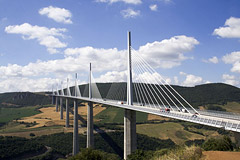
Millau Viaduct, France
Courtesy of Richard Leeming / Flickr
More from BudgetTravel.com
- 40 Unbelievable Underwater Snapshots
- Top 10 Beaches from the Movies
- 10 Most Beautiful Waterfalls
More from Yahoo! Travel
- Explore Resort and Weekend Travel
They’re the biggest, the boldest, the busiest—each of these bridges accomplishes a feat so fantastic our ancestors wouldn't have believed it possible. Yes, they're miracles of engineering, but they're also a testament to human creativity, seamlessly integrating function with style.
Tallest: Millau Viaduct, France
Not long ago, Millau — a provincial town set between two limestone plateaus in the South of France — was known for little more than its traffic jams. Every July and August, the village would become jammed with travelers en route to their summer vacations in Spain. But thanks to the Millau Viaduct, the town is now home to one of the country's major tourist attractions.
Seventeen years in the making, from the first sketches in 1987 to the final touches in 2004, the Millau Viaduct is an architectural feat in more ways than one. Sure, it is held up by the highest pylons in the world (803 feet high) and has the highest road-bridge deck in Europe (886 feet). But, most importantly, it reaches 1,125 feet at its highest point, making it the tallest bridge in the world (for reference, New York's Chrysler Building is only 1,046 feet tall). Impressive stats, to be sure, but it's the bridge's visual effect that has the most impact. Gleaming white and ultra-sleek, it cuts a striking figure against the green valley below and the blue skies above.
Best Vantage Point: Millau Viaduct is closed to pedestrians, but if you're a runner you can sign up for La Course du Viaduc de Millau, a 14-mile race that crosses the bridge. Barring that, hop in a car. The bridge was designed with a slight curve, so you can see it in its entirety just before you cross over.

Hartland Covered Bridge
Courtesy of Wladyslaw/Wikimedia Commons
Longest Covered: Hartland Covered Bridge, New Brunswick, Canada
When the Canadian government was being wishy-washy about whether or not to build a bridge across the St. John River, a group of private citizens took matters into their own hands. They formed the Hartland Bridge Company and opened the 1,282-foot-long bridge in 1901. Five years later, in what had to be a vindicating we-told-you-so moment, they sold it to the government, who took over all maintenance. Though covered bridges are now seen as quaint and old-fashioned, the icon's construction was not without its share of controversy. Shelter made sense in terms of weather—snow and ice are a sure thing throughout the winters here—but the public worried it would encourage risqué behavior among the town's youth. In the end, it was covered, and perhaps their fears were warranted: Legend has it, men would train their horses to stop halfway across the bridge so they could sneak in a kiss before crossing over to the other side.
Best Vantage Point: There's something about a covered bridge that demands you take it slow. Rather than speed across in a car, take the walkway that was added in 1945.
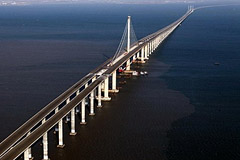
Danyang-Kunshan Grand Bridge
Courtesy of the XO Directory
Longest: Danyang-Kunshan Grand Bridge, China
When it comes to bridges, China doesn't mess around—the country is home to 11 of the world's 15 longest. Three of the top five bridges are part of the Beijing-Shanghai High-Speed Railway, a $33 billion project that will nearly double the capacity of the route to 80 million annual passengers. Opened to the public in June 2011, the Danyang-Kunshan Grand Bridge ranks as the world's longest. It stretches an astonishing 102.4 miles—that's longer than the distance between New York City and Philadelphia!
Best Vantage Point: This is a railroad bridge, so the only way to experience it is by hopping aboard the train. Thankfully, the high-speed rail travels up to 186 mph, cutting what used to be a 10-hour trip to a much more manageable five hours.
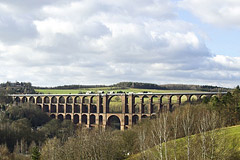
Goltzsch Valley Bridge
Courtesy of LianeM / ShutterStock
Most Bricks Used to Build a Bridge: Goltzsch Valley Bridge, Germany
At 1,860 feet long, or about one third of a mile, the Goltzsch Valley Bridge in the eastern German state of Saxony may seem like a minor player in the bridge world. But the length isn't what sets it apart; it's the material. At a time when most bridges were built with stone or metal, this one was built with bricks—20 million of them. It would be an odd (and costly) choice of material in most places, but in this area of Saxony, where there were several large clay deposits, it was an economical one. In fact, it's thanks to those same clay deposits that the second-largest brick bridge in the world, the Elster Valley Bridge, is also in Saxony; it's a quaint counterpart, made with only 12 million bricks.
Best Vantage Point: Take the autobahn to the town of Mylau, and follow the signs to the bridge from there. You'll find a designated parking lot, but don't stay there. Instead, take the path on the left-hand side just before the lot. It will lead you to a meadow, where you'll get spectacular views of the bridge.
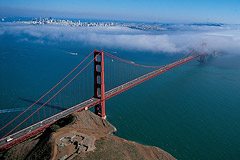
Golden Gate Bridge
Courtesy of P. Fuszard / SFCVB
Most Photographed: Golden Gate Bridge, California
With its trademark "international orange" paint, its picturesque surroundings, and the daily rolling in of the morning fog, it should come as no surprise that the Golden Gate Bridge is said to be the most photographed in the world. David Crandall, assistant professor of informatics and computing at Indiana University, thinks the numbers back up this claim. In a recent study, he tracked text tags for nearly 35 million images on Flickr to determine which world sights were shot the most. While other bridges — namely London's Tower Bridge, Florence's Ponte Vecchio, and New York's Brooklyn Bridge — were close runners-up, two simple facts gave the San Francisco structure a winning edge: geography and size.
The City of Hills has so many vantage points — and the bridge is such a looming presence in the skyline — that the Golden Gate manages to sneak into scores of photos, even when it's not the intended subject. Trying to take a shot of the Presidio? The harbor? The city skyline? There's a good chance the Golden Gate might make an appearance, whether as the main focal point or just a happy accident.
Best Vantage Point: At Kirby Cove, in the Marin headlands north of the city, you get the trifecta: a spectacular view, a healthy dose of nature, and no crowds. To get there from Highway 101, take the last exit for Sausalito and follow Conzelman Road until you reach the parking area on the left. From there, walk down the steep dirt path lined with eucalyptus and cypress trees until you reach the cove.
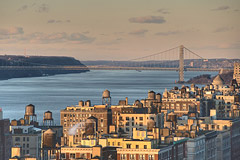
George Washington Bridge
Courtesy of Ed Yourdon / Wikimedia Commons
Most Traffic: George Washington Bridge, New York
Last year, 51 million cars, buses, and trucks traveled eastbound across the George Washington Bridge, which connects Manhattan and New Jersey over the Hudson River. Every one of New York City's 8 million residents would have to cross the bridge over six times to hit that number. Fortunately, the bridge is built to accommodate this kind of record-breaking activity, with a total of 14 lanes of traffic (eight on the upper level, six on the lower level). Of course, this statistic only takes into account motorized vehicle traffic. If you count absolutely everything that crosses the bridge, the unofficial winner is the Howrah Bridge in Kolkata, India. The eight-laner is traversed by an estimated 80,000 vehicles, as many as 1 million pedestrians—and countless cows each day.
Best Vantage Point: There are additional lanes on either side of the George Washington Bridge for pedestrians and cyclists, but that puts you too close to the action to get a good view. Instead, take the Circle Line's Full Island Cruise, a three-hour tour that circles the entire island of Manhattan and passes under seven bridges, including the George Washington Bridge. Boats leave throughout the day, but hold out for an evening departure so you'll be able to see the bridge lit up against the night sky.
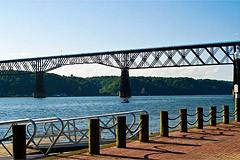
Walkway over Hudson State Historic Park
Courtesy of uticayanks820 / Flickr
Longest Footbridge: Walkway Over the Hudson State Historic Park, New York
When this 6,767-foot-long steel cantilever railroad bridge opened in 1889 over the Hudson River, it ranked as the longest bridge in the world. It carried trains across the river for 85 years until a fire damaged the tracks in 1974, forcing it to close. Thirty-five years later, after several false starts at restoration, a nonprofit group called Walkway Over the Hudson reopened the bridge, this time as a pathway for pedestrians and cyclists, in October 2009. Now a state historic park, the Walkway Over the Hudson is the longest footbridge in the world, serving as a link between trails on both sides of the river for walkers, runners, cyclists, and rollerbladers.
Best Vantage Point: In the fall, the leaves turn the banks of the Hudson into a collage of reds, oranges, and yellows. Picnic on one of the tables at either end of the bridge before strolling across, giving yourself plenty of time to snap photos along the way. walkway.org.
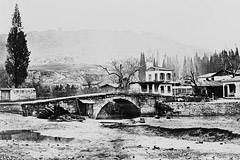
Caravan Bridge
Courtesy of Photographium
Oldest: Caravan Bridge, Turkey
At first glance, there's nothing remarkable about this bridge. The arched stone slab straddling the River Meles, in Izmir, Turkey, extends only 42½ feet and is about as simple as they come. But it's the age, not the physical aspects, of the Caravan that sets it apart. Built in 850 B.C., the bridge is 2,861 years old and has reportedly been crossed by the likes of Homer and Saint Paul. As impressive as some of the other bridges on this list are, it's hard to imagine they'll last even half that long.
Best Vantage Point: Located in old Izmir, the bridge is best reached by taxi. Simply ask your driver to take you to "Sarnic," which is the Turkish name for the bridge. We recommend going during the afternoon, when the light is best for photography.
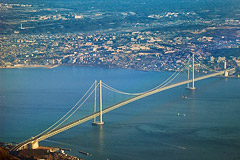
Pearl Bridge
Courtesy of Tysto / Wikimedia Commons
Longest Suspension: Akashi Kaikyo (or Pearl) Bridge, Japan
Imagine an iconic bridge (the Golden Gate, for example), and chances are you've thought of a suspension bridge. These elegant structures are formed by literally "suspending" the road deck from steel cables strung between towers. This style will never measure as far as other types—viaducts like the Danyang-Kunshan Grand Bridge are supported from below by pylons and can thus stretch as long as needed—but suspension bridges rank among the lightest, strongest, and most beautiful bridges in the world.
At nearly four times the length of the Brooklyn Bridge, Japan's Akashi Kaikyo Bridge (also known as the Pearl Bridge) is the clear winner in this category. With three connected spans—two at 3,150 feet and one at 6,532 feet—the Pearl stretches a total of 12,831 feet across the Akashi Strait from the cosmopolitan port city of Kobe to Awaji Island (which, not coincidentally, is the hub of Japan's pearl industry). Japan gets hit with extreme weather conditions, and this bridge, completed in 1998, was built to withstand them all, including winds up to 179 mph and earthquakes up to 8.5 on the Richter scale. But that doesn't mean this bridge isn't a beauty: In addition to its connection to the Japanese pearl industry, the bridge gets its nickname from the lights on its cables, which are said to resemble a strand of colorful pearls at night.
Best Vantage Point: From the Kobe side of the bridge, take an elevator to the Maiko Marine Promenade. The 984-foot tubular observation deck offers views of the strait, the bridge's interior, and Osaka Bay.
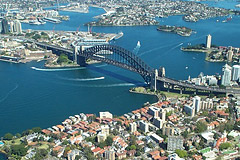
Sydney Harbour Bridge
Courtesy of Grillo / Wikimedia Commons
Widest: Sydney Harbour Bridge,Australia
Measuring 160 feet across, this suspension bridge has room for eight lanes of traffic, two railroad tracks, a pedestrian walkway, and a bicycle path. A bit much? Not when you consider that the bridge connects Sydney's business district with the residential North Shore, making it the primary route for the city's commuters. A bridge built to accommodate such volume would seem a modern-day creation, but Sydney Harbour Bridge opened back in 1932—it will celebrate its 80th birthday in 2012.
Best Vantage Point: On the walkway at the eastern side of the bridge, you'll find the entrance to the Pylon Lookout, a tower with some of the best views of Sydney and the harbor. As you climb the 200 stairs to the top, stop on each of the three levels to check out the exhibits on the history of the bridge.
Sunday, November 20, 2011
Gold’s Safe Haven Status in Question After 3.5% Sell-Off This Week
Despite its reputation as a safe place to hide from the chaos roiling global markets, gold has hardly been a bastion of strength. The yellow metal suffered a tough week falling 3.5% to close out at $1,725.10 an ounce. The price tumbled 3% on Thursday alone, actually outpacing the decline in U.S. stocks. For a traditional safe haven, the recent action has been concerning for those invested in the precious metal.
The question on the minds of gold bugs everywhere is whether this a flashing yellow light or another chance to buy the dip?
"Gold is being a save haven," insists Alix Steel, crack reporter for TheStreet.com. The metal is "going down less than the rest of the market; this is exactly what we saw in 2008," she says. During the financial crisis gold fell 20% in a few weeks then rallied up 40% for the year. Steel, who always comes prepared, also cites the following:
*ETF Demand was up 58% in Q3, despite the well-publicized selling by struggling hedge fund manager John Paulson
*Total gold investment was up 6%
*Demand for gold bars and coins rose 29%
*Central banks bought over 140 tons during Q3
The last point is critical as central bank buying around the world has been a pillar of the bullish gold case throughout the entire rally.
Steel says she hasn't heard any indications from her impressive list of sources that Emerging market central banks are doing any selling. Not only that but total buying could be as high as 450 tons for the year compared to net selling just three years ago.
Steel's conclusion is that adding gold to your holdings prudently is still a good idea provided buyers don't get too rattled by likely volatility. "Keep in mind when stocks get pummeled, commodities get pummeled, and gold will get hurt along the way," she says. But the bet is that gold just won't stay down as long.
Steel says the miners are also picking up steam lately. She points specifically to Randgold (GOLD), a stock showing strength despite the fact that the company missed Q3 earnings estimates in almost every way a company can possibly disappoint. She also likes Newmont Mining (NEM) despite dropping production because of the company's "juicy sexy dividend."
Regardless of my respect for Steel, not all the dividends nor earnings misses in a row could get me to make a bullish case for mining stocks. Gold will never change. Indeed, not changing is much of the investment thesis for gold. The miners are run by people who tend to screw up at inconvenient times.
'al-Qaida sympathizer' accused of NYC bomb plots
NEW YORK (AP) — An "al-Qaida sympathizer" accused of plotting to bomb police and post offices in New York City as well as U.S. troops returning home has been arrested on numerous terrorism-related charges.
Mayor Michael Bloomberg announced at a news conference Sunday the arrest of Jose Pimentel of Manhattan, "a 27-year-old al-Qaida sympathizer" who the mayor said was motivated by terrorist propaganda and resentment of U.S. troops in Afghanistan and Iraq.
Police Commissioner Raymond Kelly said police had to move quickly to arrest Pimentel on Saturday because he was ready to carry out his plan.
"We had to act quickly yesterday because he was in fact putting this bomb together. He was drilling holes and it would have been not appropriate for us to let him walk out the door with that bomb," Kelly said.
The police commissioner said Pimentel was energized and motivated to carry out his plan by the Sept. 30 killing of al-Qaida's U.S.-born cleric Anwar al-Awlaki.
"He decided to build the bomb August of this year, but clearly he jacked up his speed after the elimination of al-Awlaki," Kelly said.
Ten years after 9/11, New York remains a prime terrorism target. Bloomberg said at least 13 terrorist plots have targeted the city since the Sept. 11 attacks. No attack has been successful. Pakistani immigrant Faisal Shahzad is serving a life sentence for trying to detonate a car bomb in Times Square in May 2010.
Pimentel, a U.S. citizen originally from the Dominican Republic, Pimentel was "plotting to bomb police patrol cars and also postal facilities as well as targeted members of our armed services returning from abroad," Bloomberg said Sunday.
He was under surveillance by New York police for at least a year who were working with a confidential informant and was in the process of building a bomb; no injury to anyone or damage to property is alleged, Kelly said. In addition, authorities have no evidence that Pimentel was working with anyone else, the mayor said.
"He appears to be a total lone wolf," the mayor said. "He was not part of a larger conspiracy emanating from abroad."
At Pimentel's arraignment later, his lawyer Joseph Zablocki said his behavior leading up to the arrest was not that of a conspirator trying to conceal some violent scheme. Zablocki said Pimentel was public about his activities and was not trying to hide anything.
"I don't believe that this case is nearly as strong as the people believe," Zablocki said. "He (Pimentel) has this very public online profile ... This is not the way you go about committing a terrorist attack."
Pimentel, also known as Muhammad Yusuf, was denied bail and remained in police custody. The bearded, bespectacled man wore a black T-shirt and black drawstring pants and smiled at times during the proceeding.
Pimentel is accused of having an explosive device Saturday when he was arrested that he planned to use against others and property to terrorize the public. The charges accuse him of conspiracy going back at least to October 2010, and include first-degree criminal possession of a weapon as a crime of terrorism, and soliciting support for a terrorist act.
Bloomberg said at the news conference that Pimentel represents the type of threat FBI Director Robert Mueller has warned about as U.S. forces erode the ability of terrorists to carry out large scale attacks.
"This is just another example of New York City because we are an iconic city ... this is a city that people would want to take away our freedoms gravitate to and focus on," Bloomberg said.
Kelly said a confidential informant had numerous conversations with Pimentel on Sept. 7 in which he expressed interest in building small bombs and targeting banks, government and police buildings.
Pimentel also posted on his website trueislam1.com and on blogs his support of al-Qaida and belief in jihad, and promoted an online magazine article that described in detail how to make a bomb, Kelly said.
Among his Internet postings, the commissioner said, was an article that states: "People have to understand that America and its allies are all legitimate targets in warfare."
The New York Police Department's Intelligence Division was involved in the arrest. Kelly said Pimentel spent most of his years in Manhattan and lived about five years in Schenectady. He said police in the Albany area tipped New York City police off to Pimentel's activities.
Asked why federal authorities were not involved in the case, Manhattan District Attorney Cyrus R. Vance Jr. said there was communication with them but his office felt that given the timeline "it was appropriate to proceed under state charges."
About 1,000 of the city's roughly 35,000 officers are assigned each day to counterterrorism operations. The NYPD also sends officers overseas to report on how other cities deal with terrorism. Through federal grants and city funding, the NYPD has spent millions of dollars on technology to outfit the department with the latest tools — from portable radiation detectors to the network of hundreds of cameras that can track suspicious activity.
Green sidewalk makes electricity -- one footstep at a time
Paving slabs that convert energy from people's footsteps into electricity are set to help power Europe's largest urban mall, at the 2012 London Olympics site.
The recycled rubber "PaveGen" paving slabs harvest kinetic energy from the impact of people stepping on them and instantly deliver tiny bursts of electricity to nearby appliances. The slabs can also store energy for up to three days in an on-board battery, according to its creator.
In their first commercial application, 20 tiles will be scattered along the central crossing between London's Olympic stadium and the recently opened Westfield Stratford City mall -- which expects an estimated 30 million customers in its first year.
"That should be enough feet to power about half its (the mall's) outdoor lighting needs," said Laurence Kemball-Cook, a 25-year-old engineering graduate who developed the prototype during his final year of university in 2009.
The green slabs are designed to compress five millimeters when someone steps on them, but PaveGen will not share the precise mechanism responsible for converting absorbed kinetic energy into electricity.
Although each step produces only enough electricity to keep an LED-powered street lamp lit for 30 seconds, Kemball-Cook says that the tiles are a real-world "crowdsourcing" application, harnessing small contributions from a large number of individuals.
"We recently came back from a big outdoor festival where we got over 250,000 footsteps -- that was enough to charge 10,000 mobile phones," said Kemball-Cook.
The young inventor envisages PaveGen systems being used to power off-grid appliances such as public lighting, illuminated street maps and advertising, and to be installed in areas of dense human traffic such as city centers, underground stations and school corridors.
"Our main test installation is at a school in Kent (southeast England) -- where 1,100 kids have devoted their lives to stamping all over them for the last eight months," said Kemball-Cook.
In its current form, the PaveGen paving slab contains a low-energy LED which lights up, expressing the energy transfer idea to the user but only consuming around 5% of the energy from each footstep.
"This is what I really enjoy about the design," said Richard Miller, head of sustainability at the UK's government-funded Technology Strategy Board.
"As much as it's an effective, common-sense source of some sustainable electricity, it's also a great way for people to engage with the issue of sustainability ... to feel like they are part of the solution in a very immediate, fun and visual way that doesn't make you do anything you wouldn't already be doing," said Miller.
However, although generally enthusiastic about the product, for the time being Miller withholds speculation about its far-reaching impact.
"As with all things of this nature, on a large scale and in the long term, its success will be determined by how cost-effective it is to produce ... If it turns out to be expensive, then it will struggle to find a place as anything more than a niche application," he said.
Kemball-Cook declines to comment on the cost of each slab, arguing that their current price is much higher than what it will be when they go into mass production.
That said, the company has already won a spate of awards, including the Big Idea category at the UK's Ethical Business Awards and the Shell LiveWire Grand Ideas Award. PaveGen has also recently received a round of financing from a group of London-based angel investors, although the sum is undisclosed.
Kemball-Cook is confident that the slab is durable. Over the course of a month it was subjected to a machine that replicates the pounding of footsteps, non-stop every day, he added.
"It's also really easy to install as a retrofit on existing pavements, because they can be made to match their exact dimensions ... you just replace one slab with another," he said.
Looking to the future, Kemball-Cook would like to see the paving system introduced to the developing world, in areas that have a high footfall, but are off-grid, such as the slums in Mumbai.
"The average person takes 150 million steps in their lifetime, just imagine the potential," he said.
Stocks: It's all about Italy, Spain and jobs
Investors have a litany of questions for politicians in Europe and on Capitol Hill. And it's unlikely that they'll get many answers ahead of the Thanksgiving holiday next Thursday.
One major issue is whether the European Central Bank will start aggressively buying the sovereign debt of Spain, Italy and even France to stop the bondholder bleeding and woo buyers back into the EU bond markets.
Investors will also watch to see if members of Congress's so-called supercommittee can agree on tax and budget cuts ahead of this week's deadline.
Additionally, investors will get at least one key data point to gauge whether the US is indeed moving away from a possible double-dip recession: weekly initial jobless claims.
That figure will come out on Wednesday instead of Thursday due to the holiday, and a number below 400,000 could boost the markets, or at least partially offset any negative headlines out of Europe.
"The most important thing for the economy is jobs," said Paul Zemsky, head of asset allocation at ING Investment Management. "The numbers continue to improve. If we can get one more good number below 400,000, it will cement the trend."
Debt committee: Decision time
Still, investors are well aware that if the contagion from the sovereign debt crisis in Europe continues to spread, it could quickly thwart a turnaround in the US economy.
Investors will be continuing to watch bond yields around Europe. Yields on 10-year Italian bonds edged above 7%, a level that Ireland and Portugal hit just before requiring bail outs by the European Union and International Monetary Fund. Spanish bond yields hovered perilously close to that level this week.
Those yields were enough to keep all indexes down for the week, despite several positive reports highlighting an expanding US economy.
The Dow Jones industrial average (INDU) finished the week down 2.9%, and the Nasdaq (COMP) slid nearly 4%. The S&P 500 (SPX) lost 3.8%.
Investors will be watching to see whether Congress' Supercommittee can find ways to cut the budget, but a failure to do so shouldn't rattle the markets. Congress will be forced to make automatic cuts if they can't come to an agreement. That should insulate the U.S. from another potential ratings agency action.
"There's a certain degree of skepticism priced into the market, as investors believe that Congress will take the path of least resistance," said Guy LeBas, head of fixed income at Janney Montgomery Scott.
Ahead of the Thanksgiving holiday Thursday, it will be a relatively light week for third quarter earnings. Investors will focus mainly on whether the troubled computer firm Hewlett-Packard (HPQ, Fortune 500) will show signs of life when it reports third quarter earnings Monday. Campbell' (CPB, Fortune 500)s soup will report Tuesday.
Subscribe to:
Posts (Atom)